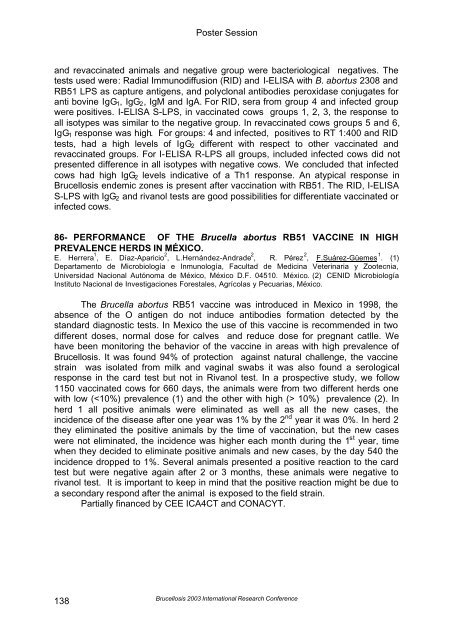Brucellosis 2003 proceedings - PHIDIAS
Brucellosis 2003 proceedings - PHIDIAS
Brucellosis 2003 proceedings - PHIDIAS
Create successful ePaper yourself
Turn your PDF publications into a flip-book with our unique Google optimized e-Paper software.
Poster Session<br />
and revaccinated animals and negative group were bacteriological negatives. The<br />
tests used were: Radial Immunodiffusion (RID) and I-ELISA with B. abortus 2308 and<br />
RB51 LPS as capture antigens, and polyclonal antibodies peroxidase conjugates for<br />
anti bovine IgG 1 , IgG 2 , IgM and IgA. For RID, sera from group 4 and infected group<br />
were positives. I-ELISA S-LPS, in vaccinated cows groups 1, 2, 3, the response to<br />
all isotypes was similar to the negative group. In revaccinated cows groups 5 and 6,<br />
IgG 1 response was high. For groups: 4 and infected, positives to RT 1:400 and RID<br />
tests, had a high levels of IgG 2 different with respect to other vaccinated and<br />
revaccinated groups. For I-ELISA R-LPS all groups, included infected cows did not<br />
presented difference in all isotypes with negative cows. We concluded that infected<br />
cows had high IgG 2 levels indicative of a Th1 response. An atypical response in<br />
<strong>Brucellosis</strong> endemic zones is present after vaccination with RB51. The RID, I-ELISA<br />
S-LPS with IgG 2 and rivanol tests are good possibilities for differentiate vaccinated or<br />
infected cows.<br />
86- PERFORMANCE OF THE Brucella abortus RB51 VACCINE IN HIGH<br />
PREVALENCE HERDS IN MÉXICO.<br />
E. Herrera 1 , E. Díaz-Aparicio 2 , L.Hernández-Andrade 2 , R. Pérez 2 , F.Suárez-Güemes 1 . (1)<br />
Departamento de Microbiología e Inmunología, Facultad de Medicina Veterinaria y Zootecnia,<br />
Universidad Nacional Autónoma de México, México D.F. 04510. México. (2) CENID Microbiología<br />
Instituto Nacional de Investigaciones Forestales, Agrícolas y Pecuarias, México.<br />
The Brucella abortus RB51 vaccine was introduced in Mexico in 1998, the<br />
absence of the O antigen do not induce antibodies formation detected by the<br />
standard diagnostic tests. In Mexico the use of this vaccine is recommended in two<br />
different doses, normal dose for calves and reduce dose for pregnant catlle. We<br />
have been monitoring the behavior of the vaccine in areas with high prevalence of<br />
<strong>Brucellosis</strong>. It was found 94% of protection against natural challenge, the vaccine<br />
strain was isolated from milk and vaginal swabs it was also found a serological<br />
response in the card test but not in Rivanol test. In a prospective study, we follow<br />
1150 vaccinated cows for 660 days, the animals were from two different herds one<br />
with low ( 10%) prevalence (2). In<br />
herd 1 all positive animals were eliminated as well as all the new cases, the<br />
incidence of the disease after one year was 1% by the 2 nd year it was 0%. In herd 2<br />
they eliminated the positive animals by the time of vaccination, but the new cases<br />
were not eliminated, the incidence was higher each month during the 1 st year, time<br />
when they decided to eliminate positive animals and new cases, by the day 540 the<br />
incidence dropped to 1%. Several animals presented a positive reaction to the card<br />
test but were negative again after 2 or 3 months, these animals were negative to<br />
rivanol test. It is important to keep in mind that the positive reaction might be due to<br />
a secondary respond after the animal is exposed to the field strain.<br />
Partially financed by CEE ICA4CT and CONACYT.<br />
138<br />
<strong>Brucellosis</strong> <strong>2003</strong> International Research Conference
















